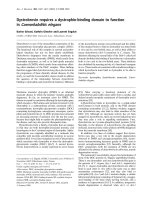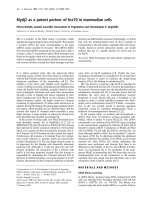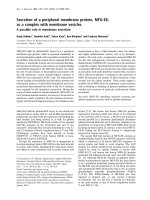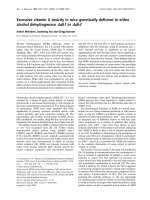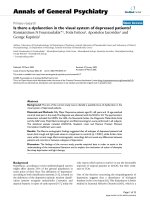Báo cáo y học: "Sarcoidosis in a dental surgeon: a case report" pps
Bạn đang xem bản rút gọn của tài liệu. Xem và tải ngay bản đầy đủ của tài liệu tại đây (498 KB, 4 trang )
CAS E REP O R T Open Access
Sarcoidosis in a dental surgeon: a case report
Luigi Checchi
1
, Maria C Nucci
2*
, Antonietta M Gatti
3
, Daniele Mattia
2
, Francesco S Violante
2
Abstract
Introduction: Although the causes of sarcoidosis are still unknown, past and current studies have provided
evidence that this disease may be associated with occupational exposure to specific environmental agents. We
describe a case of sarcoidosis in a dental surgeon with long exposure to inorganic dusts. To the best of our
knowledge, this is the first report of this kind in the literature.
Case presentation: At the beginning of 2000, a 52-year-old Caucasian man, who worked as a dental surgeon,
presented with sho rtness of breath during exercise, cough and retrosternal pain. After diagnosis of sarcoidosis, a
scanning electronic microscopy with X-ray microanalysis of biopsy specimens was used in order to determine
whether the disease could be traced to an occupational environmental agent. Results showed the presence of
inorganic dust particles within sarcoidotic granulomas, and demonstrated that the material detected was identical
to that found in a powder used by our patient for several years.
Conclusions: Although these results cannot be considered as definitive proof, they do however provide strong
evidence that this disease may be associated with material used by dental surgeons.
Introduction
Past and current studies suggest that environmental and
occupational factors may be associated with increased
risk of sarcoidosis. Sarcoidosis is a systemic granuloma-
tous disease t hat primarily affects the l ung and lympha-
tic systems of the body [1-3]. Although its causes are
still unknown, different lines of evidence associate sar-
coidosis with exposure of genetically susceptible hosts to
specific environmental agents. The possible agents
involved in the etiology of the disease include micro-
organisms, organic and inorganic dusts such as alumi-
num, zirconium, talc [1], titanium an d silicates. We pre-
sent a case of sarcoidosis in which inorganic dust
particles (silicate) were detected in biopsy material by
means of scanning e lectroni c microscopy (ESEM) tan-
dem energy dispersive spectrometer (EDS), thus provid-
ing additional e vidence that some cases of sarcoidosi s
may be due to occupational exposure to environmental
agents.
Case presentation
At the beginning of 2000, a 52-year-old Caucasian man
who worked as a dental surgeon and had never smoked,
was referred to the our Occupational Health Unit,
owing to shor tness of breath during exercise, cough and
retrosternal pain, which had become progressive ly evi-
dent in the months prior to admission. His medical his-
tory was unremarkable. Physical examination,
pulmonary function tests and blood tests were within
normal ranges. Chest X-ray showed bilateral hilar enlar-
gement and suggested hilar lymphadenopathy secondary
to sarcoidosis as a possible diagnosis. This possibility
was supported by chest computed tomography (CT)
scan, which rev ealed diffuse hilar and mediastina l lym-
phadenopathy with maximal l ymph node diameter of 3
cm. Total body scintigraphy with gallium 67 confirmed
the hilar and mediastinal lymphadenopathy. Bronchoal-
veolar lavage (BAL) showed an increase i n total cell
count and an elevated CD4/CD8 ratio compatible with
sarcoidosis, and absence of neoplastic cells or infectious
agents. Finally, cytologic examination of the aspirated
bronchial material evidenced a non-caseating granuloma
and first stage sarcoidosis was diagnosed. After lung
examination, it was decided not to start any treatment
and to evaluate the progression of the disease. There-
fore, our patient was referred for follow-up.
Given the epidemiologic evidence on the role of occu-
pational exposure in the etiology of sarcoidosis, a sam-
ple of the powder used by our patient in his work as a
* Correspondence:
2
Occupational Medicine Unit, S. Orsola-Malpighi Hospital, Bologna, Italy
Full list of author information is available at the end of the article
Checchi et al. Journal of Medical Case Reports 2010, 4:259
/>JOURNAL OF MEDICAL
CASE REPORTS
© 2010 Checchi et al; licensee BioMed Central Ltd. This is an Open Access articl e distributed under the terms of the Crea tive Commons
Attribution License ( which permits unres trict ed use, distri bution, and reproduction in
any medium, provided the original work is properly cited.
dental surgeon for at least 20 years in dental hygiene
procedures was analyzed. Analysis was performed by
electronic microscopy i n the Laboratory of Biomaterial
of the Department of Neurosciences, University of Mod-
ena and Reggio Emilia and identified the presence of
silicates among components.
During the following three years, the clinical picture
and chest CTs remained unchanged. Blood tests showed
an increase of serum angiotensin convertin g enzyme
(ACE) and GPT, where as calcium remained within nor-
mal values. Hepatic echography was also normal. In
2003, our patie nt’ s dyspnea was seriously aggravated
with episodes also occurring at rest; the chest CT per-
formed in March 2003 revealed a bilateral increase in
the number and volume of the affected mediastinal and
hilar lymph nodes, whereas the remainder of the pul-
monary parenchyma was normal. Consequently, treat-
ment was initiated with cycles of cortisone, which
produced visible improvement in the clinical picture,
reduction of the lymphadenopathy on CT after seven
months, and decline in serum ACE t o within normal
range. In 2006, while our patient’s dyspnea remained
under control with cortisone, CT showed progression of
the disease with enlargement of the hilar and mediast-
inal lymp hadenopathy and areas of interstitial thicken-
ing. Addit ional information about the possib le origin of
the disease was provided by SEM with X-ray microana-
lysis of biopsy specimens, which showed that the mate-
rial found inside the sarcoidotic granulomas was
identic al to that found in the powder used by the dental
surgeon for several years. Currently, our patient is work-
ing without using any dust for dental cleaning, his clini-
cal picture is stable with da ily cortisone treatment, and
he is under periodic control.
Discussion
The activity of dental surgeons i s associated with air-
borne exposure to aerosols of biological material and
inorga nic substances. The instruments used during den-
tal surgical procedures produce intense heat (electrocau-
tery, laser) and such procedures usually produce fumes
containing biological materi al (even partially incom-
busted). High-speed, air-driven dental hand-pieces,
ultrasonic scalers, the polishing of composite and cera-
mic restorations and the use of the milling cutter on
metallicprosthesesdispersealargeamountofaerosol
and spatter including fine particulate matter [4]. During
the polishing and whitening of natural teeth, chemical
compounds (composed by particles of sodium di-carbo-
nate and tricalcium phosphate) are sprayed on the tooth
surface detaching part of its enamel and dispersing
microparticles in the environment, thus exposing
patients and operators at risk of inhalation. For example,
a standard hygiene procedure involves the use of pro-
phylactic material and ultrasonic and/or manual instru-
mentation [5]. The prophylaxis phase can be substituted
by an artificial bicarbonate aerosol. Artificial cleaning
aerosols are formed by a Mini-Clean device (Castellini,
Bologna, It aly) with air pressure set at six to seven
atmospheres and water flow at one atmosphere. Each
individual run lasts 20 to 30 minutes for each pat ient. It
has been repor ted that 95% of the particles measure less
than five micrometers and are mainly concentrated
within two meters of the patient where they can be
easily inhaled by dental clinicians. For this reason, the
patient always protected himself with a face mask (3 M
ESPE 1942 F.B. (1800 NL) resistant molded face) whose
level of efficiency was 90 to 92% [6,7].
To test our hypothesis that sarcoidosis could be
related to an environment al agent in this case, a further
examination of biopsy specimens was performed. Sec-
tions of the lung biopsy were sent to the Laboratory of
Biomaterials to be analyzed by Environmental Scanning
Electron Microscopy. For elemental analyses, conducted
by means of an Energy Dispersive Spectrometer (EDS by
EDAX), the instrument was equipped with an X-ra y
microprobe. When debris was detected, a microanalysis
was carried out to check their chemical composition. At
the same time, and under the same working conditions,
the inorganic chemical content of the biological tissues
surrounding these particles w as investigated and corre-
lated to the chemistry of the particles. Considering our
patient’s long exposure to dust, a hypothesis was pro-
posed that the particulate matter can originate from the
wear of materials used during abrasion and polishing
operations. It was put forward that the material used for
dental cleaning procedures could have a similar chemis-
try to that of the found debris. A sample was observed
under ESEM and analyzed by EDS. The spectrum
obtained proved similar to that of the debris found in
the lung (Figures 1 and 2).
Conclusions
Although the relationship between dental material with
silicates and sarcoidosis has not, to the best of our knowl-
edge, been discussed i n literature, these findings provide
evidence that dental surgeons’ occupational exposure to
inorganic dusts might be a relevant factor in the onset of
sarcoidosis. We think that similar cases should be
reported in order to help identify environmental agents
that could be involved in the pathogenesis of sarcoidosis.
Consent
Written informed consent was obtained from the patient for publication of
this case report and any accompanying images. A copy of the written
consent is available for review by the Editor-in-Chief of this journal.
Checchi et al. Journal of Medical Case Reports 2010, 4:259
/>Page 2 of 4
Figure 1 Spectrum of the particles of calcium phosphate found in the lung biopsy.
Figure 2 Particles of calcium phosphate found in the lung biopsy.
Checchi et al. Journal of Medical Case Reports 2010, 4:259
/>Page 3 of 4
Competing interests
The authors declare that they have no competing interests.
Authors’ contributions
MCN was the principal investigator, conceived the study and drafted and
revised the manuscript. LC was responsible for considerations regarding
dental materials and working procedures. AMG was responsible for electron
microscopy analyses. LC was responsible for considerations regarding
biomaterials and helped draft and revise the manuscript. FSV supervised the
entire work and assumes responsibility for the entire manuscript. All authors
read and approved the final manuscript.
Author details
1
Department of Periodontology and Implantology, School of Dentistry,
University of Bologna, Italy.
2
Occupational Medicine Unit, S. Orsola -Malpighi
Hospital, Bologna, Italy.
3
CNISM, Laboratory of Biomaterials, Department of
Neurosciences, University of Modena and Reggio Emilia, Italy.
Received: 20 January 2009 Accepted: 10 August 2010
Published: 10 August 2010
References
1. American Thoracic Society Statement on Sarcoidosis: Am J Respir Crit Care
Med 1999, 160:736-755.
2. Newman LS, Rose CS, Bresnitz EA, Rossman MD, Barnard J, Frederick M,
Terrin ML, Weinberger SE, Moller DR, McLennan G, Hunninghake G,
DePalo L, Baughman RP, Iannuzzi MC, Judson MA, Knatterud GL,
Thompson BW, Teirstein AS, Yeager H Jr, Johns CJ, Rabin DL, Rybicki BA,
Cherniack R, ACCESSResearch Group: A case control etiologic study of
sarcoidosis: environmental and occupational risk factors. Am J Respir Crit
Care Med 2004, 170:1324-1330.
3. Gorham ED, Garland CF, Garland FC, Kaiser K, Travis WD, Centeno JA:
Trends and occupational associations in incidence of hospitalized
pulmonary sarcoidosis and other lung diseases in Navy personnel: a 27-
year historical prospective study, 1975-2001. Chest 2004, 126:1431-1438.
4. Gross KB, Overman PR, Cobb C, Brockmann S: Aerosol generation by two
ultrasonic scalers and one tonic scaler: a comparative study. Journal of
Dental Hygiene 1992, 66:314-318.
5. Legnani P, Checchi L, Pelliccioni GA, D’Achille C: Atmospheric
contamination during dental procedures. Quintessence International 1994,
25:435-439.
6. Legnani P, Leoni E, Lipparini M, Checchi L, Pelliccioni GA: Contaminazione
aerea. Dispositivi individuali di protezione. Dental Cadmos 1999, 5:25-33.
7. Checchi L, Montevecchi M, Moreschi A, Graziosi F, Taddei P, Violante FS:
Efficacy of three different masks in preventing inhalation of airborne
contaminants in dental practice. JADA 2005, 136:877-882.
doi:10.1186/1752-1947-4-259
Cite this article as: Checchi et al.: Sarcoidosis in a dental surgeon: a
case report. Journal of Medical Case Reports 2010 4:259.
Submit your next manuscript to BioMed Central
and take full advantage of:
• Convenient online submission
• Thorough peer review
• No space constraints or color figure charges
• Immediate publication on acceptance
• Inclusion in PubMed, CAS, Scopus and Google Scholar
• Research which is freely available for redistribution
Submit your manuscript at
www.biomedcentral.com/submit
Checchi et al. Journal of Medical Case Reports 2010, 4:259
/>Page 4 of 4



